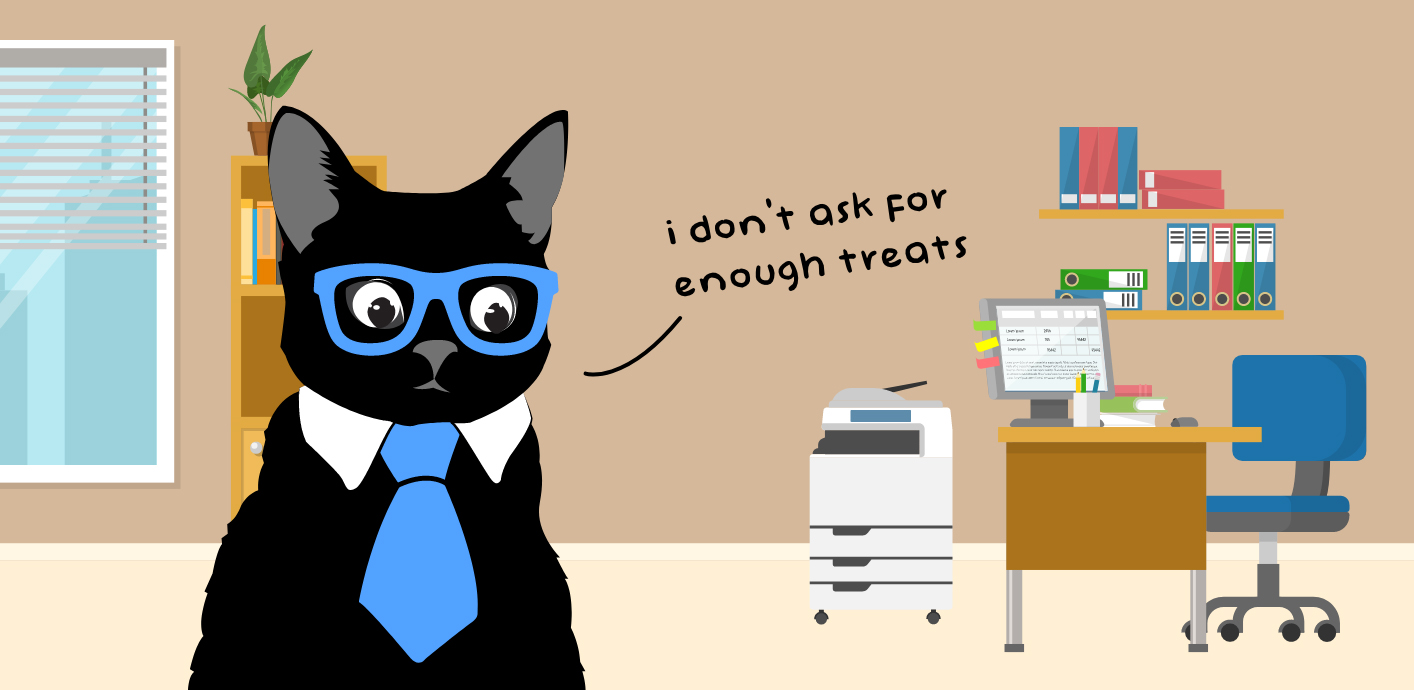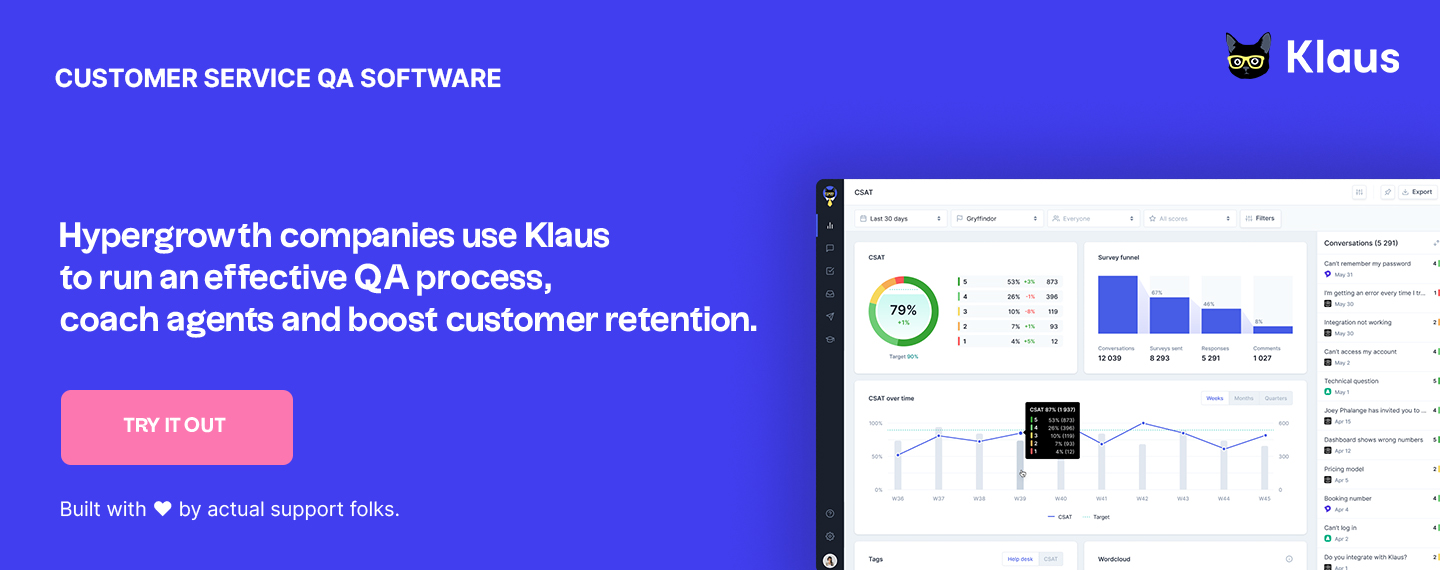Self-evaluation is an important aspect of a performance review. It’s an opportunity for employees to reflect and consider what their strengths and weaknesses are – not only for growth as a worker but as a person. By critiquing their own work and behavior, employees can gain insight that helps them improve.
Have you ever had someone compliment you on a skill that you thought you were bad at? Do you understand your personal shortcomings and areas where you can improve? If you’re running a customer support team and doing regular purr-formance reviews, you might consider adding a self-evaluation component to the review.
Give your employees a chance to highlight their accomplishments and areas where they shine. But it’s also beneficial to provide them with an opportunity to voice areas where they struggle. Here are some things to consider if you’re thinking about starting customer service self-evaluations.
What Is a Self-Evaluation?
A customer service self-evaluation is a questionnaire that an employee completes before a regular performance review to discuss the answers with the manager. It can be a series of questions along with a section where the employee can rate their abilities in certain areas. When worded correctly, these evaluations can provide valuable insight into the employee and provide a starting place for an action plan.
As an employee, you can use self-evaluation as a vehicle to acquire help in needed areas and highlight the areas in which you excel. As a manager, a self-evaluation gives valuable insight into your employee’s skill sets and the ability to identify their strengths and weaknesses.
Why Use a Self-Evaluation Component in Customer Service Performance Reviews?
A customer service self-evaluation provides both the employer and the employee with the opportunity to open the lines of communication and build trust. It’s also a good tool to start the customer service performance review. As a manager or leader, you can give the self-evaluation to the employee a week or few days before their performance review to give them adequate time to complete it.
Customer service self-evaluation can help your team in:
- Aligning customer support with quality standards
- Learning what drives customer satisfaction
- Providing feedback to the team
- Smoother onboarding of new agents
Conversation Reviews Help to Highlight Specific Cases
Conversation Reviews (also called Interaction Reviews, Customer Service Quality Assurance, or Quality Control) have become a standard practice for all quality-oriented and ambitious customer service teams. Though simple in nature, these procedures can bring immense value to your business.

It’s like code review for software developers or the editorial process for writers: it’s a systematic means of training and onboarding agents by reviewing their support interactions. The goal of support QA is to improve and maintain support quality.
Reviewing your own customer interactions helps to work towards the same customer support goals and develop a framework for targets and activities.
Here’s a strategy you can follow:
Outline Your Customer Support Objectives
Companies have different priorities about what matters most to them and their customers. For instance, a firm may want to maintain brief and quick interactions with clients, while another may wish to be more engaging to drive conversions. Therefore, it’s a great idea to start by defining what quality means for your organization.
Develop Internal Quality Standards
Now that you have a support vision and goals in place, devise guidelines for your support professionals to follow during their interactions with customers. The agents can use these self-assessment standards to tell whether their responses are in line with the organization’s goals. This takes the guesswork out of trying to meet expectations.
Consider using the following rating criteria to rank interaction quality, depending on your business needs:
- Product knowledge and accuracy
- Solution completeness
- Response correctness
- Tone and empathy
- Followed processes
- Personalization
Choose Conversations to Review
Filter out a mix of conversations to review to get an accurate picture of your customer service quality. You can select a random sample of customer interactions, or filter by the number of replies, the time it took to complete the request or conversations that were escalated or received a lower CSAT score.
Track Performance Through Feedback
The reason for reviewing conversation reviews is to rate your performance, but what to do with the results? Review the results on a 1:1 meeting, and put together a training plan fit for the reviewee’s needs. Team leads and managers can pull together common themes for team training.
Read more
Customer Service Quality Assurance – The Complete Guide
#EmpowerCustomerCare: 7 Tips for Support Managers
How Your Support Team Can Double as Your PR Team
How to Have Great 1-to-1s With Your Support Team
How Do You Create and Respond to a Customer Service Self-Evaluation?
Here are some leading questions and statements along with possible responses to aid managers and employees in navigating a customer service self-evaluation:
Please list your primary responsibilities.
It’s always good to learn your employee’s understanding of their responsibilities.
What other tasks do you routinely perform?
Your employee might be working on other tasks that you aren’t aware of or acknowledging them for. You want to create trust with this question.
What improvements do you believe should be made to the department?
Even as a manager, there are things you might not know or notice. Your employees might have some great suggestions. This question also highlights areas where the employee thinks things can be improved.
What one customer interaction are you most proud of since we last met?
This is a great way for the employee to show you their ideas of outstanding customer service.
What one customer interaction do you wish you could change in retrospect?
As an employer, you want to know what the employee thinks they might have done better at when dealing with clients.
What do you think are your biggest strengths and weaknesses?
You want your employee to start with the positive and move to areas of improvement, and this type of question does that.
What improvements have you made since your last performance review?
This gives the employee to highlight their growth as an employee. It shows that the employee has worked on their action plan.
What training or resources would help you to improve your performance?
It’s always beneficial to trust your employees to know what they need. Since they’re handling the hands-on portion of customer service, they’re more in tune with what can make them successful and improve their performance.
What can I do to help you improve your skills or product knowledge?
You want all of your employees to do well because it better serves your customer, so you must learn ways to help your staff make improvements.
Create a list of areas where the employee can rate their overall performance
After the open-ended question, it’s a good idea to list a variety of areas with a rating system. This list should include:
- Communication
- Teamwork
- Creative solutions
- Overall performance
- Professional improvement
- Decision-making
- Dealing with stressful situations
You can tailor this list to meet your own needs. Offer the chance for the employee to rate themselves on a scale from one to five, with space for comments or notes.
Possible Responses for Employees
As an employee, performance reviews can be daunting, and customer service self-evaluation can challenge your ability to describe your own strengths and weaknesses. Your manager wants you to be successful. They want you to grow and improve, and many managers want to help you with this process. This makes it essential that you provide thoughtful answers to customer service self-evaluation.

Questions concerning communication:
Positive response: “I believe in the value of active listening and communication. I use my communication skills to build lasting relationships with customers and team members.”
Negative response: “I struggle to effectively communicate with our clients at times. Sometimes, I allow my emotions to color my communications. It’s an area that I’m working to improve.”
Questions concerning problem-solving skills:
Positive response: “Since my last review, I was faced with (detail a problem that arose), and I was able to solve it by (insert the solution). I believe that this customer interaction shows my unique ability to quickly understand and solve problems as they occur.”
Negative response: “I always strive to come up with creative solutions for problems that arise that benefit the company and our customers; however, I feel like it’s an area that I could greatly improve upon with coaching and training.”
Questions concerning teamwork:
Positive response: “I enjoy working as part of a team and feel that I contribute to the work of the team. Since my last review, I have worked with a team on (detail a particular project or event that highlights your contribution to a team). I’d enjoy more opportunities to highlight my skills in teamwork.”
Negative response: “When working as part of a team, I struggle with my need to control a situation and must learn how to allow others to handle their portion of the work and take the lead. I’ve attempted to improve my teamwork skills by (insert an example here).
Questions concerning the ability to adapt quickly:
Positive response: “As the situation changes, I’m able to pick up on nuances quickly and adjust my strategy for helping the customer in minutes. I always try to adapt and to begin applying all new rules and requirements in my department.”
Negative response: “When presented with new tasks and responsibilities, I find it challenging to add them to my routine. I struggle to recognize changes in the direction of the project as soon as they occur. It’s an area that I could benefit from additional training.
Questions concerning time management:
Positive responses: “I’m able to complete all of my tasks and responsibilities on time. Prioritizing jobs is a skill that I excel at during busy periods. I thrive on working under a deadline or handling multiple customer service issues at once.”
Negative response: “When things are busy, I miss deadlines or find myself struggling to complete all of my tasks on time. I’m working on my time management skills by keeping a prioritized to-do that I adjust as issues turn up.”
Self-assessment is Continuous
Self-assessments enable employees to reflect on themselves and discover their strengths and weaknesses. They are vital for career growth and self-development.
While many organizations recommend annual employee performance evaluations, self-assessment should be an ongoing and regular process. Constant communication and feedback within an organization inform everyone where they stand, encouraging employees to improve.
Use a Conversation Review Tool
You can simplify self-assessment conversation evaluation using a conversation review platform. With the right software tool, you will spend a small fraction of the time used retrieving customer and agent interactions manually or using spreadsheets.
Further, a conversation review platform can quickly generate actionable metrics that you can use to discuss agent performance and set goals.



